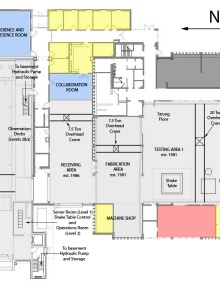Facilities
Layout of SEESL
SEESL includes four large spaces as shown in the adjacent plan view. The original laboratory space (Testing Area 1) was completed in 1983 and is located at the south end of the facility. The newer, larger laboratory space (Testing Area 2) was completed in 2004 and is at the north end. The other two spaces are used for storage, receiving and fabrication and are located between the two main laboratory spaces.
Apart from SEESL, Ketter Hall also houses many of the Civil and Structural Engineering faculty offices and a number of smaller laboratories used for structural and geotechnical engineering for research and instruction.









